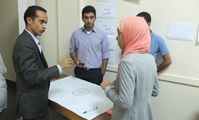Home
/ About Egypt / Egypt - Stars in season
Egypt - Stars in season

Created: Jul 17, 2010,
modified: Jan 13, 2012,
overall rating: 0.000
On 6 July, the Alexandria Opera House (Sayed Darwish Theater) offered a very special evening.
Without any doubt, in nearly 100 years since it was founded, the Alexandria Opera House has not witnessed 116 violins on the same stage; the sheer number raised eye brows. Together they played compositions by Bach, Vivaldi, Handel, Beethoven, Dvoàk, amongst others. Sitting with other excited listeners, I witnessed the gradual entry of Suzuki's class students onto the stage, all holding violins, starting with advanced, through to younger students and down to five-year-old beginners. The evening was a culmination of the what the Suzuki classes had accomplished in Cairo and Alexandria.
The concert opened with four soloists: Seif Gamal, Sarah Sherif, Doha Eweiss and Lena Naasana, who played the first movement (Allegro) of Vivaldi's Concerto for 4 Violins in B Flat Major. Afterwards, more violinists came on stage and the group played together the 3rd movement (Allegro assai) of J.S. Bach's Concerto for Violin in A Minor. Each piece performed this evening represented works studied by Suzuki students, played in a sequence starting from the most advanced to the least. Thus, the sequence continued with the 2nd movement (Allegro) of Handel's Sonata for Violin and Piano, then the 1st movement from Vivaldi's Concerto for Violin in A minor, to more simple pieces such as Bourrée by Bach, Humoresque by Dvoàk, Gavotte by Bach and Minuet in G by Beethoven. The youngest violinists were always supported by the more advanced group already on stage. They played a beautiful variation of an English folk song, 'Long, Long Ago', Hunters' Chorus by CM von Weber as well as Bach's Minuet. Last but definitely not least, were children from the 1st year of Suzuki's classes. Their repertoire includeв a few compositions arranged for the violin by Shinichi Suzuki: Andantino, Perpetual Motion, Allegro and lovely variations of Twinkle, Twinkle Little Star.
Shinichi Suzuki (1899-1998), violinist and creator of the 'Suzuki method' (which is also known as the mother-tongue method) was born in Nagoya, Japan. His father was the owner of the largest violin factory in Japan. In Japan and then in Germany, Suzuki started learning to play the violin at rather late age of 17. Upon his return to Japan, Suzuki formed a string quartet with his brothers and in parallel started teaching violin to small children. This is when he reached the realisation that for his youngest students, the process of learning music was very similar to acquiring a mother tongue. Children from an early age acquire their mother-tongue by listening to it, by repeating sounds, words and phrases and only then gradually improving pronunciation and using grammatical logic. Likewise, music can be taught by listening and repeating and hence become part of a children's consciousness. By creating his own curriculum of violin studies, Suzuki proved that music makes children happy, endorses equality; talents thrive easily when they are surrounded by the right environment.
Over recent decades, many music centres and educators have followed the Suzuki method to teach children how to play various instruments. The Suzuki method reached Egypt with a Japanese team in the early 1990s. Osman El-Mahdy, Egyptian violinist (Concert-master of the Cairo Opera Orchestra 1994-2005 and also Professor of Violin and Chamber Music at Cairo Conservatory, 1989- 2005), was trained in the Suzuki method in both Cairo and Tokyo, by Professor Takeshi Kobayashi, a former student of Shinichi Suzuki.
In November 1993, El-Mahdy launched his own Suzuki classes - predictably for violin, at the Talents Development Centre of the Cairo Opera House. Today a group of 150 students, at seven levels, follow Suzuki violin lessons taught by El-Mahdy and his team: Fawzy Ibrahim, Nihad Gamal, and Mohamed Harb in Cairo. Under El-Mahdy's supervision, Nevine El-Mahmoudy takes responsibility for the Suzuki classes in Alexandria. At the end of each academic year, both groups from Cairo and Alexandria, gather to give their final concert at the Main Hall, Cairo Opera House. This year, for the first time, the annual concert took place in Alexandria.
Suzuki's approach differs from traditional academic methods practised by music schools and conservatories worldwide. There are many success stories that confirm that it works, at least as a start for those wishing to pursue a professional career. Mohamed Harb - one of the current teachers in El-Mahdy's team, became a Suzuki student at the age of six. At 18, he was accepted at the Cairo Conservatory and later joined the Cairo Symphony Orchestra. This year he will be heading to Dresden Conservatory to obtain his Masters. Mohamed Aly Farag started in Suzuki in 1995 and later joined Toronto University where he studied composition and violin. He graduated two years ago. El Mahdy recalls "Basma Edrees, who started with me back in 1995, is now completing her violin studies at the Mannes Music School in New York. Yasmin Tayeby joined Suzuki in 1994 and in 2005 she received a full scholarship to study at the Berklee College of Music. She graduated here a few weeks ago as a composer. Some members of the younger generation have joined Cairo Conservatory but not graduated yet.".
Suzuki lessons have thus changed the lives of many people. However, some Suzuki students also pursue careers, not related to music or the arts. In spite of this, they never seem to put away their violins. Many of El-Mahdy's students have graduated from prestigious universities and are now successful engineers, doctors, business administrators etc. They always stay in touch with their classmates and El-Mahdy. "Besides learning to play the violin, which is the main reason children join Suzuki, students develop a very special link with each other. They all care and help each other. Many of the parents have also become close friends over the years."
It is a great pity that, in Egypt, though essential to the development of a child's personality, music tends to be marginalised by educational institutions and ignored by many families. Music (and the arts) make us alert to new aesthetic values. They boost receptiveness, memory and concentration. Apart from physical and emotional coordination, children gain higher self esteem and a sense of their individual value. The Suzuki method shows that, through music, children can become good amateur musicians, as well as better human beings, bringing hope to an entire generation.
The Suzuki students' concert gives us hope that there are still families that believe in the importance of music education. When a five year-old child plays a simple tune on his small violin, our spirits are lifted. With their beautiful stage presence, violins in hands and eyes are fixed on their teacher. Suzuki students of all ages at the concert, displayed a serious attitude and proved once again, that music is a great means of directing young energy.
Ati Metwaly
Arts and Culture Editor, Ahram Online
#LISA
Your Rating:
Overall rating: 0.000
Totally voted: 0
Comments
Login/Registration
Weather in:
Exchange Rates
1 USD = 16.200 LE
1 EUR = 18.040 LE
News
-
IMF loan expected next month
Apr 22, 2013, rating: 3.000, 3 votes Egypt may secure an International Monetary Fund loan agreement in about amonth, state news agency MENA reported, quoting "informed" sources ...
Egypt may secure an International Monetary Fund loan agreement in about amonth, state news agency MENA reported, quoting "informed" sources ...
-
Egypt received 11 million tourists in 2012 and aims to boost that number to 14 million in 2013.
Jan 22, 2013, rating: 3.000, 2 votes
Egypt received 11 million tourists in 2012 and aims to boost that number to 14 million in 2013.
-
Egypt limits travelers leaving country to US$10,000 in cash
Dec 26, 2012, rating: 3.250, 4 votes Egypt has banned travelers from carrying more than US$10,000 in foreigncurrency cash in or out of the country ...
Egypt has banned travelers from carrying more than US$10,000 in foreigncurrency cash in or out of the country ...
-
National Coalition on Climate Change for Egypt is born
Nov 30, 2012, rating: 5.000, 1 votes The global COP18 conference on climate change opens in Doha Monday.About 17,000 participants from all over the world ...
The global COP18 conference on climate change opens in Doha Monday.About 17,000 participants from all over the world ...
-
Egyptian family's average annual income is LE25,000, agency reports.
Nov 29, 2012, rating: 5.000, 1 votes The average annual Egyptian household income during 2010-2011 wasLE25,353, according to the Central Agency for Public Mobilization andStatistics.
The average annual Egyptian household income during 2010-2011 wasLE25,353, according to the Central Agency for Public Mobilization andStatistics.
-
Judgment for sexual harassment
Nov 14, 2012, rating: 3.600, 5 votes A man was sentenced to two years in prison and fined LE 2,000 for sexually harassing a woman, an ...
A man was sentenced to two years in prison and fined LE 2,000 for sexually harassing a woman, an ...








